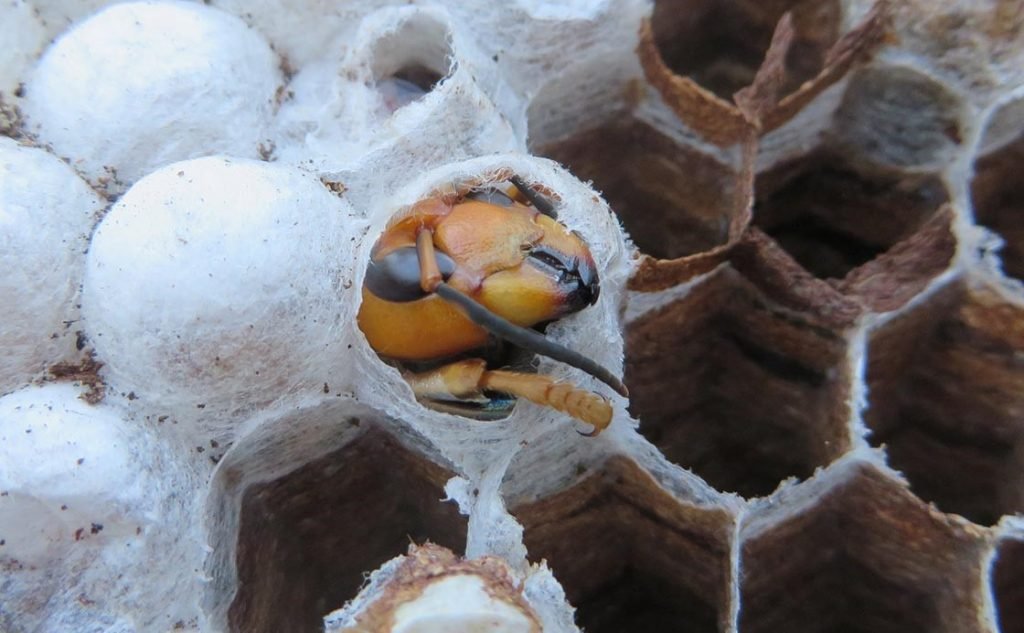Morphology and Classification of Asian Giant Hornets
The Asian giant hornet is the world’s largest hornet with a size of approximately 3.5 cm long that of worker hornet while the queen hornet ranges from 4 to 5 cm in length including its wingspan that is 4 to 7 cm long.
They have a large and thick orange or yellow head and their bodies are marked with different shades of yellow or orange with black stripes.
Scientific classification of Asian giant hornets
- Kingdom: Animalia
- Phylum: Arthropoda
- Class: Insecta
- Order: Hymenoptera
- Family: Vespidae
- Genus: Vespa
- Species: mandarinia
Geographical Distribution of Asian giant hornets
- They are also known as “Japanese giant hornet” and are native to East Asia, South Asia, Mainland Southeast Asia, and the Russian Far East.
- Later, it was reported in the United States in late 2019 with two Asian giant hornets near Blaine. It was also verified in Canada during the fall of 2019 in British Columbia.
- Asian giant hornet favors temperate and tropical regions living in low mountains and forest rather than high altitude climates.
- Therefore, they can be found in China, Taiwan, Laos, Thailand, Vietnam, Nepal, India, Sri-lanka, Japan, Korea, and Russia.
- While no hornets have been reported in North America.
- Asian giant hornets are often confused with other species of hornets and wasps even though they are much larger than others. They can only be confirmed by a specialist or entomologists.
- Vespa mandarinia and Vespa velutina are the two most common species of Asian giant hornets found in the Southern part of Asia.
- Dolichovespula maculata is common throughout Ontario which is a Bald-faced hornet much smaller than the Asian giant hornet.
- Vespa crabro and Vespa velutina is a European hornet which is often mistaken with the Asian giant hornet.
- Other common species are V. tropica, V. magnifica and V. nobilis which differs in color.
Habitat
- Asian giant hornets prefer low human habitats in low mountain foothills and lowland forests.
- They nests where it is difficult to locate like in rotten pine roots, digging into the ground, pre-existing tunnels dug by borrowing animals like rodents and snakes.
- The nest is about 20 inch deep with the entrance horizontal, inclined or vertical.
- Usually nests have seven combs. The middle comb is the largest which occupy to the bottom of the nest.
- The hornet queens prefer narrow cavities.
Nesting cycle of Asian Giant Hornets

(Source: http://www.bugsfeed.com/asian_giant_hornet)
- Pre nesting period: Inseminated and uninseminated queens hibernate in early to mid-April after feeding on the sap of an oak tree. V. mandarinia queens form a hierarchy where the top-ranked queen begins feeding following the circle of another queen around. The top queen starts feeding following the second to last.
- Solitary, cooperative, and polyethic periods: The queen begins to raise 40 small workers in the small cell. These workers do interior activities while queens work outside the hive. A nest becomes fully developed in early August with three combs and 500 cells. No eggs are laid but only larvae care about mid-September. In late October, the queen dies.
- Dissolution and hibernating period: The body color and weight of the males and new queen changes. Before the hibernation, the male and queen mates once the queen emerges out of the nest and leaves for hibernation. Many queens remain unfertilized when they fight off males. Both males and queens do not return once they leave the nest.
Effects of Asian Giant Hornets on native honey bees

(Source: https://www.scienceabc.com/nature/animals/what-are-murder-hornets-and-how-dangerous-are-they.html)
- The Asian giant hornets are more aggressive towards the colonies of the honey bee. They are capable of invading 30,000 bees within hours.
- They attack honey bee colonies in three phases:
- Hunting phase: At the entrance of the colony, an individual hornet will capture bees and cut their heads off, and form a meatball from the thorax. Then they return to feed their young the protein-rich meal.
- Slaughter phase: Numerous hornets kill all the worker bees by ripping off their head and dumping their bodies on the ground and return to the nest with their prey.
- Occupation phase: Hornet collects the pupae and larvae from the beehive to feed their young and captivates the beehive.
- Asian giant hornets are the predators of honey bees from spring to mid-summer. Therefore, beekeepers must remain careful throughout this time with pests in their yard.
Effects of Asian Giant Hornets on humans

(Source:http://tonynwajeipost.blogspot.com/2013/10/deadly-giant-hornets-kill-42-people-in.html)
- Asian giant hornets do not cause any effect in pets, livestock, and humans until and unless if you get too close to its nest and threaten their colonies.
- The stinger of the giant hornet is venomous with a 6mm length. Its venom contains bee and wasp venom with a neurotoxin that damages the internal body tissue.
- Its multiple stings cause anaphylaxis and severe toxicity that may lead to death due to its large size, the dose of toxicity is larger than other hornets.
- Yearly 12-26 deaths have been reported from the stinging from its venom.
- Beekeeping suits cannot protect from the stinging, specialized protective equipment is required for full protection.
Prevention and control methods of hornet
- One of the best control methods is by destroying and removing its nest by applying poisons or burning with fire.
- Crushing the hornets with a wooden stick during the bee hunting phase because during that period they do not counterattack.
- Placing a trap at the entrance of the beehives that the hornets cannot escape through it due to its large size and place at the capture chamber where hornets are left to die.
- Controlling hornets with different measures of resistance like weeds, wire, or fishing nets which traps the hornets with these protective screens.
References:
- https://en.wikipedia.org/wiki/Asian_giant_hornet
- https://invasivespecies.wa.gov/priorityspecies/asian-giant-hornet/#:~:text=What%20Are%20its%20Characteristics%3F,Wingspan%20is%20about%203%20inches.
- https://www.nytimes.com/2020/05/02/us/asian-giant-hornet-washington.html
- https://agr.wa.gov/hornets
- https://www.ontario.ca/page/asian-giant-hornets
- https://ugaurbanag.com/facts-about-the-asian-giant-hornet/#:~:text=The%20Asian%20giant%20hornet%20is,being%20stung%20by%20these%20hornets.